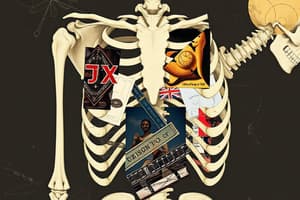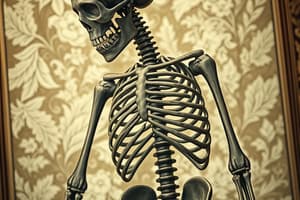Podcast
Questions and Answers
What role does vitamin D play in calcium regulation?
What role does vitamin D play in calcium regulation?
- It prevents bone resorption.
- It promotes loss of calcium through the kidneys.
- It increases calcium absorption from the intestine. (correct)
- It decreases calcium absorption from the intestine.
What is the primary substance that forms the matrix of bone?
What is the primary substance that forms the matrix of bone?
- Collagen (correct)
- Calcium phosphate
- Osteoid
- Hydroxyapatite
Which cells produce calcitonin?
Which cells produce calcitonin?
- Parathyroid cells
- Osteoblasts
- Osteoclasts
- Parafollicular cells of the thyroid gland (correct)
What type of bone is characterized by collagen fibers arranged in a parallel fashion?
What type of bone is characterized by collagen fibers arranged in a parallel fashion?
What effect does calcitonin have on osteoclast activity?
What effect does calcitonin have on osteoclast activity?
How does parathyroid hormone (PTH) influence vitamin D synthesis?
How does parathyroid hormone (PTH) influence vitamin D synthesis?
Which bone cell type is primarily responsible for bone resorption?
Which bone cell type is primarily responsible for bone resorption?
Which type of bone is particularly known for its honeycomb appearance?
Which type of bone is particularly known for its honeycomb appearance?
What is the primary stimulus for calcitonin secretion?
What is the primary stimulus for calcitonin secretion?
What is the first unmineralized bone tissue formed during new-bone formation?
What is the first unmineralized bone tissue formed during new-bone formation?
Which of these is NOT a function of bone?
Which of these is NOT a function of bone?
What feature distinguishes compact bone from cancellous bone?
What feature distinguishes compact bone from cancellous bone?
Where are osteoblasts primarily developed from?
Where are osteoblasts primarily developed from?
What is the primary role of osteoclasts in bone remodeling?
What is the primary role of osteoclasts in bone remodeling?
Which vitamin is essential for collagen production in bones?
Which vitamin is essential for collagen production in bones?
What is the sequence of the bone remodeling cycle?
What is the sequence of the bone remodeling cycle?
How does Wolff's Law describe bone adaptation?
How does Wolff's Law describe bone adaptation?
What happens during the reversal phase of the bone remodeling cycle?
What happens during the reversal phase of the bone remodeling cycle?
Which mineral is particularly important for the activity of osteoblasts?
Which mineral is particularly important for the activity of osteoblasts?
What characterizes the response of bone to mechanical stress?
What characterizes the response of bone to mechanical stress?
Which of the following is NOT a factor that affects normal bone growth?
Which of the following is NOT a factor that affects normal bone growth?
What initiates the differentiation of osteoclasts from their precursors?
What initiates the differentiation of osteoclasts from their precursors?
Which component of bone provides tensile strength?
Which component of bone provides tensile strength?
In endochondral ossification, what occurs in the hypertrophic zone?
In endochondral ossification, what occurs in the hypertrophic zone?
What happens to osteoblasts at the end of the bone-forming cycle?
What happens to osteoblasts at the end of the bone-forming cycle?
How is the molecular structure of mature bone primarily held together?
How is the molecular structure of mature bone primarily held together?
Which type of collagen predominates in the unmineralized matrix of bone?
Which type of collagen predominates in the unmineralized matrix of bone?
What is the primary mineral that makes up nearly half of the bone volume?
What is the primary mineral that makes up nearly half of the bone volume?
What role do osteoclasts play in bone dynamics?
What role do osteoclasts play in bone dynamics?
Which hormone primarily increases the number and activity of osteoclasts?
Which hormone primarily increases the number and activity of osteoclasts?
What is the role of sex hormones in bone health?
What is the role of sex hormones in bone health?
Which of the following factors can lead to decreased ionized calcium levels?
Which of the following factors can lead to decreased ionized calcium levels?
How does calcium play a role in muscle contraction?
How does calcium play a role in muscle contraction?
Which statement about calcium homeostasis is correct?
Which statement about calcium homeostasis is correct?
What effect does human growth hormone (HGH) have on the body?
What effect does human growth hormone (HGH) have on the body?
What is the dominant regulator of parathyroid hormone (PTH) secretion?
What is the dominant regulator of parathyroid hormone (PTH) secretion?
Which description about vitamin D is accurate?
Which description about vitamin D is accurate?
Flashcards are hidden until you start studying
Study Notes
Bone Composition and Structure
- Bone is a strong, rigid, and regenerative framework that protects organs, supports marrow, stores calcium and growth factors, and participates in acid-base balance.
- Bone undergoes constant modeling (reshaping) and remodeling (replacement of old bone with new) to adapt to changing forces and maintain strength.
- Bone matrix is primarily collagenous with mineral salts and cells: osteoblasts, osteocytes, and osteoclasts.
- Osteoid is unmineralized new bone seen during active bone formation.
- Woven bone is the immature, disorganized bone with haphazardly arranged collagen fibers and cells.
- Lamellar bone is the mature bone with parallel collagen fibers forming layers (lamellae) with osteocytes between.
- Compact (cortical) bone, dense and strong, is found in areas requiring support, composed of haversian systems (osteons).
- Cancellous (trabecular) bone has a honeycomb structure, found in bone interiors, especially in the ends of tubular bones and vertebral bodies.
- Periosteum, a tough membrane covering bones except at articular ends, contains bone-forming cells.
- Osteoblasts, responsible for bone formation and osteoclast activation, differentiate from mesenchymal precursors in bone marrow and periosteum, influenced by growth factors like bone morphogenetic proteins (BMPs).
- Osteocytes, resting osteoblasts embedded in the matrix, are involved in maintaining bone health.
- Osteoclasts, large, multinucleated cells, are the primary mediators of bone resorption, developing from hematopoietic marrow precursors under the influence of osteoblastic stromal cells.
- Hydroxyapatite, a crystalline form of calcium and phosphate, forms almost half the bone volume. Collagen provides tensile strength, while hydroxyapatite contributes to compressive resistance.
- Type I collagen fibers constitute over 80% of the unmineralized bone matrix, forming a network with mucopolysaccharide and ground substance that serves as a scaffold for mineral deposition.
Bone Development and Growth
- Bone development occurs through endochondral ossification (cartilage model ossification) and intramembranous ossification (direct ossification).
- Endochondral ossification, the prevalent method for tubular bone development, involves four zones:
- Resting chondrocytes in the epiphysis.
- Proliferative zone where chondrocytes multiply.
- Hypertrophic zone where chondrocytes mature and calcify.
- Calcified cartilage zone undergoing osteoclastic resorption and ossification with blood vessel ingrowth from the diaphysis.
- Intramembranous ossification involves direct mesenchymal cell differentiation into osteoblasts at the periosteum (appositional bone formation). This occurs during flat bone formation (skull, mandible, clavicles) and in response to trauma or tumor growth.
- Endochondral ossification, the prevalent method for tubular bone development, involves four zones:
- Remodeling is the continuous replacement of old bone with new, involving osteoclasts for resorption and osteoblasts for deposition.
- Bone remodeling cycle:
- Activation: Osteoclasts are activated and resorb bone.
- Resorption: Osteoclastic resorption occurs.
- Reversal: Resorption stops, and osteoblasts take over.
- Formation: Osteoblasts form new bone, completing the cycle.
- This cycle takes about 100 days in compact bone and 200 days in spongy bone.
- Bone remodeling cycle:
- Wolff's Law: Bone adapts its strength and shape to mechanical stresses, reinforcing areas of high load.
- Mineral Requirements for Bone Growth:
- Adequate calcium and phosphorus (for hydroxyapatite) are crucial.
- Magnesium deficiency inhibits osteoblast activity.
- Boron plays a role in bone growth.
- Manganese deficiency hinders new bone formation.
- Vitamins D, C, A, and B12 are essential for bone remodeling.
- Vitamin C deficiency reduces collagen production, delaying bone growth and fracture healing.
- Vitamin A regulates osteoblast and osteoclast activity, deficiency slowing skeletal growth.
- Vitamin B12 may play a role in osteoblast activity.
- Hormonal Influence on Bone Growth:
- Human growth hormone (HGH) promotes overall tissue growth, including bone growth.
- Sex hormones (estrogen and testosterone) enhance osteoblast activity.
- Insulin and thyroid hormones (T3 and T4) facilitate normal bone growth and maturation.
- Parathyroid hormone (PTH) increases osteoclast activity, promotes calcium recovery from urine, and stimulates calcitriol formation.
- Calcitonin inhibits osteoclast activity, increases calcium absorption from blood, and accelerates calcium deposition in bones.
Calcium Homeostasis
-
Total plasma calcium is 2.5 mmol/L (range: 2.1-2.6 mmol/L), tightly regulated, with only ionized calcium (Ca2+) being biologically active.
-
Ca2+ homeostasis involves:
- Intestine: Absorption.
- Bone: Storage and resorption.
- Kidney: Excretion.
-
Hormonal Regulation:
- Parathyroid hormone (PTH): Secreted by parathyroid glands, PTH is the primary regulator of calcium homeostasis. It increases plasma calcium levels and lowers plasma phosphate levels.
- Vitamin D: A lipid-soluble vitamin that increases intestinal calcium absorption, bone resorption, and decreases renal calcium loss. Active form (1,25-dihydroxycholecalciferol) stimulates osteoblast-mediated osteoclast activation and osteocytic osteolysis. PTH stimulates vitamin D synthesis.
- Calcitonin: Synthesized and secreted by parafollicular cells of the thyroid gland. Calcitonin is antagonistic to PTH, decreasing plasma calcium levels by inhibiting osteoclast activity, leading to decreased bone resorption.
-
Key Functions of Calcium:*
-
Preserves bone density.
-
Essential for bone formation, maintenance, and construction.
-
Enables nerve and muscle functions.
-
Facilitates neurotransmitter release.
-
Plays a vital role in cell and connective tissue maintenance.
-
Regulates cell division.
-
Contributes to enzyme and hormone production involved in digestion, energy, and fat metabolism.
Studying That Suits You
Use AI to generate personalized quizzes and flashcards to suit your learning preferences.




